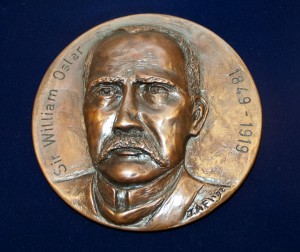Join us at a reception to mark the opening of the exhibit On the Surface/Skin Deep this Wednesday, April 1, from 5:30-6:30 in the Osler Library exhibition space on the 3rd floor of the McIntyre Building.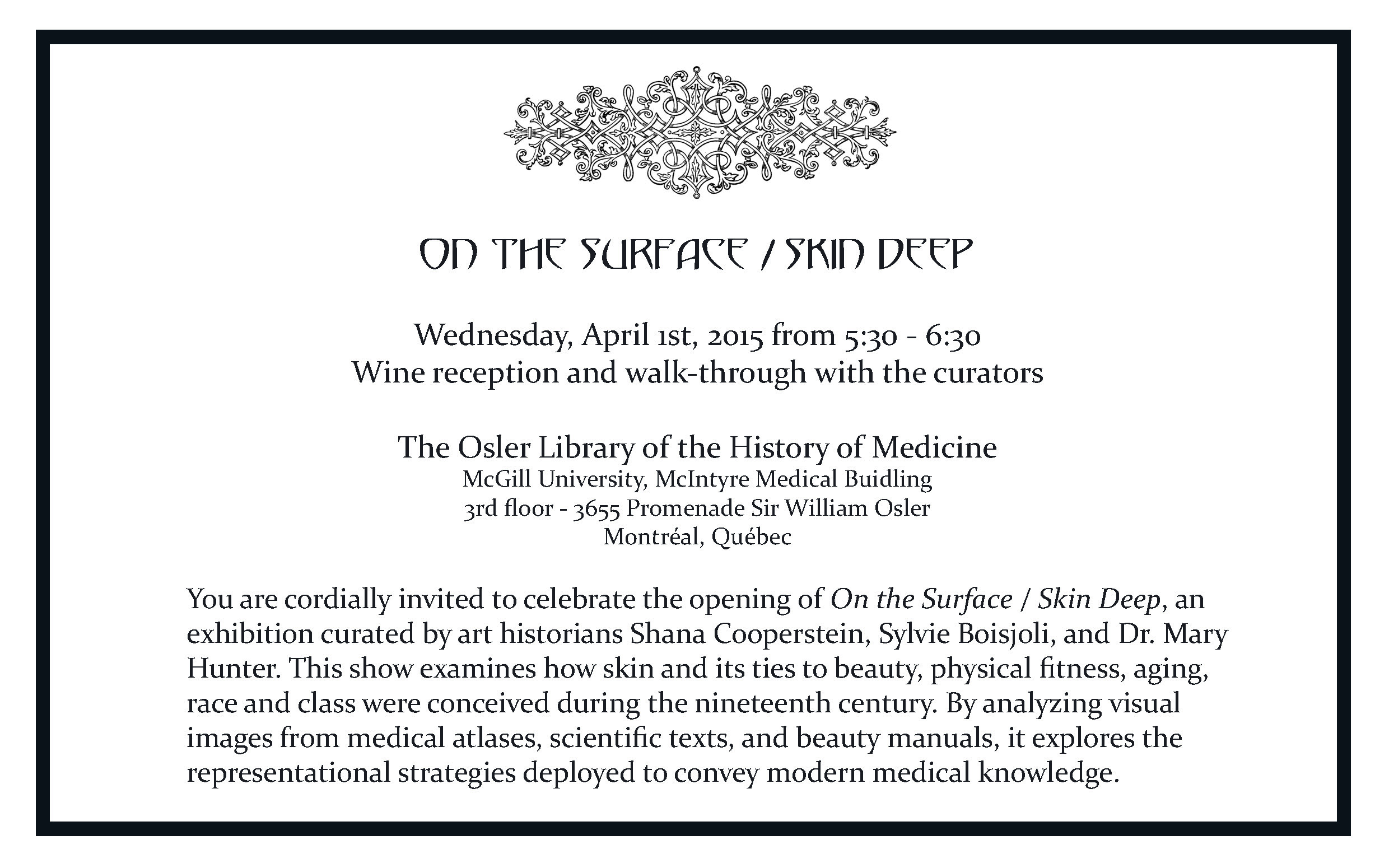
Monthly Archives: March 2015
2014 Osler Essay Contest Winners
The three winning essays from the 2014 round of the Osler Society and Osler Library Board of Curators Essay Contest have now been made available on our website. There was a tie for first place this year between Julian Z. Xue and Gabriel Devlin. In the essay “On Sir William Osler’s Relationship with Death,” Julian Xue (MDCM 2014) examines Osler’s personal experience of loss and argues that these encounters with death moulded his views both philosophically and practically. Gabriel Devlin (MDCM 2017) contrasts the patient-doctor relationship in North American and Southern Europe, finding that while medical paternalism was tempered in North America in the mid-20th century due to public scandals involving medical experimentation and the anti-paternalism of equal rights movements, it continues to shape doctor-patient interactions around the Mediterranean. Third place in the contest was awarded to David Benrimoh for his essay “The Zeroth Law of Medicine,” which investigates the role of physicians and the American Medical Association as an largely oppositional force in the move towards universal health care coverage in the United States. Congratulations to the winners!
The Osler Society and Osler Library Board of Curators Essay Contest was founded in 2013 to promote student research in the history, social studies, sociology, ethics, and humanities of the health sciences. Participants select a topic and are then mentored by an expert drawn from the Osler Library’s Board of Curators or elsewhere to complete their project, drawing on the rich resources of the library. The three top finalists present their essays on Osler Day in November. Prizes are awarded t of $250 for third place, $500 for second place, and $1,000 for the winning essay. The first-place winner is also awarded the Osler Library Board of Curators’ medal.
Interested in participating in this year’s contest? We are currently accepting proposals, due May 1st. Find more details here.
Announcing the Edward H. Bensley Research Travel Grant recipients
The Osler Library is pleased to announce that we have selected three researchers out of a very worthy pool of applicants to receive this year’s Dr. Edward H. Bensley Research Travel Grants to support their work at the Osler Library. This year’s recipients are Dr. Sasha Mullally, Dr. Elma Brenner, and Emily Lockhart.
Dr. Mullally is a professor of history at the University of New Brunswick. She holds a doctorate in history from the University of Toronto and is a specialist in the social history of medicine and health in Canada and the US. She is currently co-investigator on a study of the history of medical diasporas in Canada, a SSHRC- and AMS/Hannah Foundation-funded research project. Her work at the Osler Library will investigate the history of physicians immigrating to Canada in the second half of the 20th century.
Dr. Brenner works at at the Wellcome Library in London as a specialist in medieval and early modern medicine. She was previously a post-doctoral research fellow at the Pontifical Institute of Medieval Studies, where she also earned a Licence in Medieval Studies. She holds a doctorate in history from the University of Cambridge and has published on the history of leprosy in the Middle Ages. At Osler she will be looking at a number of early printed works on the “French Disease,” a disfiguring illness roughly equivalent to modern-day syphilis.
Emily Lockhart is Toronto-based photographer, designer, and curator. As a travel grant recipient, she will continue her work on a historical photographic project with McGill’s School of Architecture. The project explores the spaces of medical instruction at McGill in the wake of World War I and today by reproducing a collection of 146 glass plate negatives taken by McGill medical student James R. Lockhart (1890-1980) after the war and rephotographing the places that appear in the historic photographs as they now exist.
Congratulations to all of our 2015 recipients!
The Dr. Edward H. Bensley Research Travel Grant is endowed through generous gifts from the McGill Medicine Class of 1936 and the Pope-Jackson Fund. The grant honours Dr. E. H. Bensley’s place in the history of the Osler Library, as a former dean of the Faculty of Medicine at McGill who devoted the latter part of his life to the study of the history of medicine. For more information about the research travel grant, please see our website.
Medieval medical manuscript available digitally
The Osler Library’s copy of a medieval medical text written by Johannes de Sancto Paulo (John of Saint Paul) is one of our manuscripts that are available digitally. Bibliotheca Osleriana 7627 is a small early 13th century Latin manuscript containing the Breviarium medicine (“Breviary of medicine”) written by Johannes de Sancto Paulo (fl. 1180), as well as an excerpt from the Liber Pantegni compiled and translated from Arabic into Latin by Constantine the African (1020?-1098/99?). It was rebound probably in the late 19th century in vellum over boards with beautiful marbled pastedowns. The volume belongs to William Osler‘s original donation to the library and is catalogued in his Bibliotheca Osleriana (1). Osler acquired the manuscript from the rare books dealer Luigi Lubrano of Naples in October of 1915.
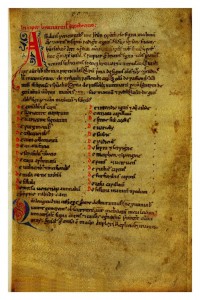
First leaf of the Breviary, with the incipit, an opening line written in red announcing the title of the text (referred to in this copy as the “Breviary of Hippocrates”) and table of contents. BO 7627.
Johannes de Sancto Paulo was a physician active in Southern Italy during the late 12th and early 13th century. He is thought to be among the masters of the Salerno school of medicine, a center for medical teaching and knowledge production well-known for bringing the work of Arabic medical writers into Europe through Latin translation. The breviary, one of four known works by Johannes de Sancto Paolo, is a general guide to practical medicine written probably around the third quarter of the 12th century.
The text is divided into five books. The first book discusses some practical issues about diagnosing and understanding disease, for example, recognizing signs of illness. It also discusses diseases that affect the entire body, like leprosy and skin conditions such as erysipelas. The second book contains conditions relating to the head and upper body, including the respiratory system. In this book are descriptions of and treatments for “psychological” conditions like mania and lethargy, head pain, eye pain, impaired vision, coughs, and asthma.
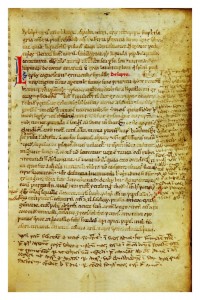
Chapter on leprosy, De Lepra from BO 7627. A popular topic, one early reader has added a lot of notes in the margin.
Book 3 concentrates on the digestive system with entries on vomiting, stomach pain, diabetes, and more. Book 4 is on the reproductive system and women’s issues like retention of menses and womb suffocation (two worrisome conditions for medieval doctors). Book 5 is on different types of fevers, which medieval people identified as a disease in itself rather than a symptom of illness, as we understand it today.
The second text bound in the manuscript appears to have been written somewhat later than the first. It was often a common practice to bind single texts together in the same binding.
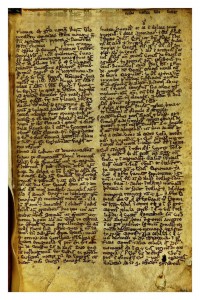
A short extract from the Pantegni section on medical theory, theorica, likely transcribed by a medieval medical student. BO 7627.
The title of the manuscript’s second text, the Pantegni, comes from the Greek words pan and techne, meaning “all the art,” referring to the art of medicine, and was a large compendium of both practical medical treatments and medical theory. These pages are possibly the work of a student copying an extract of this well-known medical textbook for his own reference purposes. In the margin above where the writing begins, the scribe has scrawled in a short plea–sancti spiritus assit nobis gratia. Que cordi nostra sibi faciat, the opening (although slightly garbled) lines of a sequence hymn for the Christian holiday of Pentecost: “May the holy spirit be with us now. May he fashion to him our hearts.”
Further reading:
See a digitized copy of the oldest manuscript of the Pantegni (probably written under the supervision of Constantine himself) from the Dutch National Library here.
To find out more about medieval medicine in general, take a look at Nancy Siraisi, Medieval & early Renaissance medicine: an introduction to knowledge and practice (Chicago, 1990) or Faith Wallis, Medieval medicine: a reader (Toronto, 2010).
A great (and entertaining) resource on medieval manuscripts is the blog Medieval Fragments. A good intro to understanding and researching manuscripts is Raymond Clemens and Timothy Graham, An introduction to manuscript studies (Ithaca, NY, 2007).
References
(1) Sir William Osler, Bibliotheca Osleriana: a catalogue of books illustrating the history of medicine and science (Montreal, 1969).
(2) Monica H. Green, “Johannes de Sancto Paulo,” in Medieval science, technology, and medicine: an encyclopedia, ed. Thomas Glick, Steven J. Livesey, and Faith Wallis (New York, 2005).
Directions for Preserving Health in St. Louis, 1874
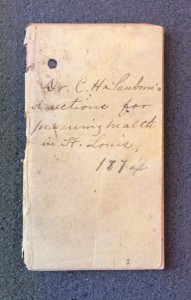
“Dr. C. H. Sanborn’s Directions for Preserving Health in St. Louis, 1874.” Osler Library Archives, P192
The Osler Library recently acquired a short manuscript booklet containing one doctor’s medical advice for patients moving out of town. Labelled “Dr. C. H. Sanborn’s directions for preserving health in St. Louis, 1874,” this tiny treatise provides advice and recipes for treating day-to-day complaints and guidelines for stocking the family medicine cabinet with the essentials.
Dr Charles H. Sanborn was a physician practicing in New Hampshire. Born in Hampton Falls in 1822, he graduated with an MD from Harvard Medical School in 1856 (1). He practiced medicine for over forty years in his hometown, where he also served as a Justice of the Peace and in local government (2). This autograph booklet appears to have been written by him for a family of three moving from New Hampshire to St. Louis, Missouri.
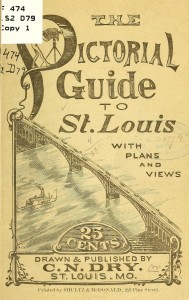
“The Pictorial Guide to St. Louis,” 1877. From the Internet Archive.
During the second half of the 19th century, St. Louis was undergoing a population explosion that would make it the fourth largest city in the U.S. after New York, Philadelphia, and Chicago. Expanding sectors, such as the cotton industry, and new railroad connections attracted an influx of new residents, perhaps including Dr. Sanborn’s patients. The city was prone to cholera and had lived through an epidemic that killed more than 3,500 residents in 1866, just eight years prior to the writing of Dr. Sanborn’s pamphlet. (3)
Fittingly, Dr. Sanborn’s medical advice concentrates heavily on cholera and other, less acute gastro-intestinal complaints associated with moving to new climes. The first page of medical instructions deals with how to treat “Diarrhea, Dysentery or Cholera Morbus” in the youngest member of the family. Remedies include starch, castor oil, bismuth, and, in the case of feverishness, veratrum viride, a highly toxic plant sometimes used during the 19th century in the treatment of typhoid fever and yellow fever.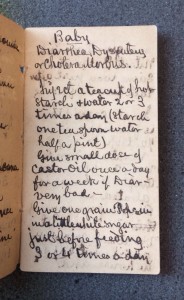
Up until the late 19th and early 20th century, the majority of medical treatment took place at home. Popular printed medical manuals would have been readily available for purchase and families would have expected to care for their sick themselves:
The skills, knowledge, and responsibilities of laypersons and physicians overlapped; trained physicians were in a functional sense always consultants–with the primary caregiver a family member, neighbor, or midwife.(4)
In the case of Dr. Sanborn’s patients, the father was perhaps the one responsible for making medical decisions and treating his family. Advice for particular ailments is oftentimes labelled “Baby” or “Self & Wife,” and includes detailed instructions for treating croup, “lung fever,” measles, the “Shakes,” “weakness sinking etc. etc.,” sore throat, painful menstruation, inflamed eyes, burns, and bug bites. A list in the back of the book ennumerates the items that should be kept on hand for medical usage.
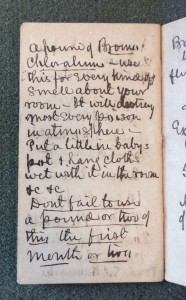 One of the chemicals on this list attests to the persistence of the miasma theory of disease into the second half of the 19th century, even as germ theory was beginning to emerge in scientific circles around the same time. Disease, it was thought, was transmittable by poisoned air, marked by a bad smell. Dr. Sanborn suggests the use of bromo-chloralum, a harsh disinfectant, to “destroy most every poison in the atmosphere.” He urges it to be used liberally in the baby’s room and all around the house: “Don’t fail to use a pound of two in the first month or two.”
One of the chemicals on this list attests to the persistence of the miasma theory of disease into the second half of the 19th century, even as germ theory was beginning to emerge in scientific circles around the same time. Disease, it was thought, was transmittable by poisoned air, marked by a bad smell. Dr. Sanborn suggests the use of bromo-chloralum, a harsh disinfectant, to “destroy most every poison in the atmosphere.” He urges it to be used liberally in the baby’s room and all around the house: “Don’t fail to use a pound of two in the first month or two.”
______________________________
This pamphlet is now available for consultation in our archives. You can find it listed on the Osler Library Archives database. For more information, please contact the library.
Further reading:
W. F. Bynum, Science and the Practice of Medicine in the Nineteenth Century. Cambridge: Cambridge University Press, 1994.
William G. Rothstein, American Physicians in the Nineteenth Century: From Sects to Science. Baltimore: Johns Hopkins University Press, 1972.
Charles E. Rosenberg. Our Present Complaint: American Medicine, Then and Now. Baltimore: Johns Hopkins University Press, 2007.
Charles E. Rosenberg, ed. Right Living: An Anglo-American Tradition of Self-Help Medicine and Hygiene. Cambridge: Cambridge University Press, 1992.
References
(1) Harvard University. Quinquennial catalogue of the officers and graduates, 1636-1930. (Cambridge, MA, 1930).
(2) Warren Brown, History of the Town of Hampton Falls, New Hampshire from the Time of the First Settlement within its Borders, vol. 1 (Manchester, NH, 1900.); The New Hampshire Register, Farmer’s Almanac, and Business Registry for 1871 (Claremont, NH, 1871).
(3) History of St. Louis, (1866-1904) http://en.wikipedia.org/w/index.php?title=History_of_St._Louis_(1866%E2%80%931904)&oldid=638231408
(4) Charles Rosenberg, ed. Right Living: An Anglo-American Tradition of Self-Help Medicine and Hygiene. (Cambridge, 1992), 4.


